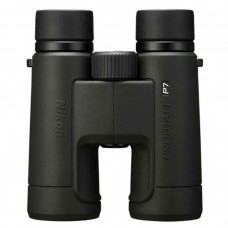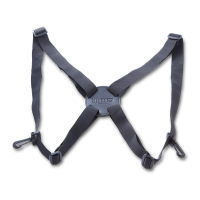Recommended Accessories
Steiner Comfort Harness
N$395.00 Ex Tax:N$395.00
Full-sized and full-featured, the Nikon PROSTAFF P7 10x42 Binoculars deliver crisp views and stand up to the rigors of travel and trekking. The 10x magnification shows you details at a distance. Multiple layers of antireflective and dielectric coatings on the prisms deliver sharp views with vivid colors, while a non-stick coating makes it easy to keep the objective and eyepiece lenses clean. You can lock in a customized diopter setting, which is helpful when friends or family members are also using the binocular. The PROSTAFF P7 are waterproof, fogproof, and drop-resistant, so you can carry them confidently on your outdoor adventures.
Maximum Brightness, Powerful Magnification
PROSTAFF P7 10x42 binoculars deliver 10x magnification, while maintaining a bright view thanks to the larger objective lenses.
Renowned Nikon Optics
P7 binoculars incorporate superior Nikon optics and lens coatings for a high-quality viewing experience.
Outstanding Clarity
Multilayer lens coatings cut glare and reflection for sharper, clearer views.
Higher Definition
Phase-correction coating is applied to the roof prisms for increased definition and clarity.
Brighter, Sharper Colors
Nikon's dielectric high-reflective multilayer prism coating maximizes light transmission across the visible range.
Waterproof Down to 3.3'
Although
they're not intended for underwater use, the PROSTAFF P7 binoculars can
safely be used around splashing water or in inclement weather.
Locking Diopter Ring
Often reserved for the highest-end binoculars, the diopter ring locks into place so you can set it and forget it.
Eco-Friendly Glass
The glass used in PROSTAFF P7 binoculars is lead-free and arsenic-free. Better for you. Better for the environment.
Non-Stick Coating for Easy Cleaning
An
oil- and water-repellent coating is applied to both the objective and
eyepiece lenses. Simply wipe away moisture, fingerprints, and smudges.
Lenses That Won't Fog
The
PROSTAFF P7 binoculars are filled with bone-dry nitrogen gas, so even
going from a warm car to the cold winter air won't fog the lenses.
Turn-and-Slide Eyecups
Retract them for use with eyeglasses. Extend them to your ideal position for comfortable naked-eye viewing.
Long Eye Relief
15.7mm of eye relief ensures everyone can find a clear, comfortable viewing position, with or without eyeglasses.
Tough-Skinned
The green rubber-armored body provides non-slip grip and protection from the occasional drop or bump.
Hard-Bodied
The lightweight body of the PROSTAFF P7 binoculars features strong fiberglass-reinforced polycarbonate resin.
| Product Specification | |||||||||||||||||||||||||||||||
| Specifications | Performance
Features
General
|
||||||||||||||||||||||||||||||
Nikon Prostaff P7 10x42
- Brands Nikon
- Product Code:Nikon Prostaff P7 10x42
- Availability:In Stock
-
N$6,995.00








